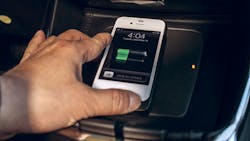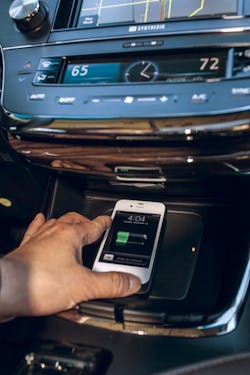The Life Of Qi: In-Car Wireless Charging Steps Up A Gear
A new in-vehicle wireless charging system, implemented with Qi and RFID technology, lets drivers charge their smartphones while driving. The driver need only place his or her Qi protocol-enabled phone (34 mobile-phone models currently have Qi wireless charging) onto a charging mat that forms part of the vehicle’s dash panel. The system has been designed into the 2013 Toyota Avalon.
In 2008, the Wireless Power Consortium, which now boasts about 100 members including HTC, Motorola Mobility, Nokia, Samsung, and Sony, signed an agreement for an open standard for wireless power. Called Qi, it’s based on induction charging technology that involves transmitting energy via a magnetic field.
Devices that operate with the Qi standard rely on magnetic induction between planar coils. Two kinds of devices are involved—basestations that provide inductive power, and mobile devices that consume inductive power. The basestation has a power transmitter comprising a transmitting coil, while the mobile device features a power receiver with a receiving coil. Close spacing of the two coils, as well as shielding on their surfaces, ensures efficient inductive power transfer. The use of appropriate shielding is important because it reduces the driver’s long-term exposure to the magnetic field.
Related Articles
• Toshiba Launches ARM Cortex-M3 For In-Car Audio And Video Apps
• Gridlock Gizmos— Will iCAR Get Into Gear?
• Microsoft, Siemens Collaborate On In-Car Entertainment
Power-efficiency claims for Qi typically range around 70%. However, efficiency can drop to 40% depending on the distances involved in the power transfer.
A technical challenge with inductive charging has been its lack of efficiency and increased resistive heating. Compared to direct contact charging methods, it’s more expensive in equipment terms because it requires additional electronics and coils in both device and charger.
Another typical criticism of the system actually works as a positive when it comes to in-vehicle use of wireless charging: The mobile phone must stay in position on the charging mat, which prevents drivers from using the phone while driving (unlike cable-connected recharging methods).
Toyota's Avalon will feature a wireless charging system that, thanks to Qi and RFID technology, lets drivers charge their smartphones while driving.
The Avalon’s wireless charging system relies on technology developed by Hong Kong-based ConvenientPower and Philips Lite-on Digital Solution (PLDS). ConvenientPower is a specialist in wireless power charging and related intellectual property. It co-designed Qi and co-founded the Wireless Power Consortium.PLDS designs and develops optical disk-drive products for automotive infotainment applications. Itsmajor research centre is based in Germany.
Last year, worldwide car production reached approximately 80 million units. Due to the relentless escalation of the vehicle population, it’s important for in-car induction systems to be able to charge a broad range of devices, regardless of brand, manufacturer, or type of device. This also is a key design consideration for infrastructures such as those in cars, where there’s a large diversity of user devices. Another critical factor is the backward-compatibility of the Qi standard to maintain seamless charging experiences as Qi technology evolves over time.
No doubt, then, an important element in the continuing implementation of induction charging is to ensure that systems can recognize different products and the amount of charge they need.
On that front, Israeli company Powermat uses RFID tags to identify what is being placed in the charging position. The RFID tags are held in a case made to fit around popular gadgets like iPods, laptops, and mobile phones. When a gadget is positioned on a Powermat, it reads the RFID tag to identify the device and ensure that it only receives the required charge.

